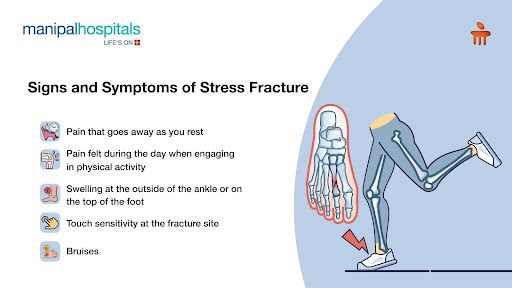Activity modification plays an important role in rapid healing from fractures. Blood flow and oxygen are vital for the healing of fractures caused by bone breaks. Hence, increased blood vessel enlargement brought on by exercise, which does not involve the fractured part, increases the flow of nutrients, oxygen, and growth factors to the fracture site. This promotes the growth of new bone, an essential stage in the healing process for broken bones. Between 0.7% and 20% of all injuries seen in sports medicine clinics are stress fractures. Among all athletes, track and field competitors had the highest rate of stress fractures. This blog post describes what is a stress fracture and steps to overcome stress fractures.
Synopsis
About Stress Fracture
Stress fractures are a frequent condition that can significantly affect everyday activities and athletic performance, yet they are occasionally underdiagnosed. These tiny injuries, frequently brought on by overuse or persistent stress, can develop in different body parts. Although it can occur to anyone or those who start exercising more intensely all of a sudden, athletes and high-impact users are more likely to experience it.
Causes Of Stress Fractures
-
An abrupt increase in physical activity: Doing more activities more frequently, like working out more days a week.
-
Bone deficiencies: Even when engaging in regular daily activities, you may be at risk for a stress fracture if you have osteoporosis or other long-term medical disorders that weaken the bones.
-
Inappropriate methodology: A stress fracture could result from anything that modifies the way your foot absorbs force when it hits the ground.
-
Modification of surface: Stress fracture risk may rise with a change in training or playing surface, such as a tennis player switching from a grass court to a hard court or a runner switching from a treadmill to an outdoor track.
-
Inadequate tools: Wearing fragile or old shoes that can no longer absorb shocks could be a contributing factor.
Signs and Symptoms of Stress Fracture

Usually, the pain starts slowly and gets worse when you try to bear weight. Additional signs and symptoms could be present, such as:
-
Pain that goes away as you rest
-
Pain felt during the day when engaging in physical activity
-
Swollen feet at the outside of the ankle or on the top
-
Touch sensitivity at the fracture site
-
Bruises
If the symptoms persist, consult our best Orthopaedician in Mukundapur to map out your ideal treatment.
Activity Modification: What Is It?
-
Functional modification is the process of modifying your workouts to reduce stress on specific body parts, such as muscles, joints, or bones, in an attempt to prevent further injuries.
-
Being able to keep active by making adjustments to your regular exercise regimen is crucial for your general health, regardless of whether you have an arthritic joint, a bad case of tendinitis, or an acute injury that has left a limb temporarily immobile.
-
As an alternative to more conventional exercise, non-impact and low-impact activities are frequently advised by orthopaedic and spine doctors. Running is a terrific exercise, but it's not something the average person should continue into later adulthood without risking major bodily consequences.
-
Stretching and range-of-motion exercises for muscles and joints other than the afflicted hip may be advised by your doctor to preserve strength and enhance blood flow, which promotes recovery.
-
Ankle fractures and sprains of the knee ligament are examples of lower extremity ailments that frequently help with upper body strength. As an alternative, upper extremity injuries (such as rotator cuff issues or wrist fractures) can permit some degree of lower body exercise.
-
The goal of activity modification is for your injury to heal first and foremost suitably and without difficulty. You must consult your doctor before beginning any workout regimen.
Take Care Of Your Fracture
-
Rest: Stop all physical activities temporarily, particularly the sport or activity that broke your bone.
-
Icing: Cover your wounded bone with ice or a cold pack.
-
Elevating your injury: You can use pillows or cushions to elevate your leg when you're lying down if the stress fracture is in your foot or leg.
-
Compression: Compression helps lessen swelling and blood flow to the fractured bone.
-
Immobilisation: To support your injury and lessen the pressure you exert on it, you may need to wear a cast, boot, or special shoe.
Treatment for Stress Fracture
If not healed by the above methods, fractures might need intensive medical care. Treatment includes painkiller medications, physiotherapy, and, in rare cases, minor surgical procedures to treat the fracture. Consult our Orthopaedics Hospitals in Mukundapur to know more about the stress fracture treatment options.
Conclusion
Finally, an important aspect of stress fracture rehabilitation is activity modification or functional remodelling. Collaborate with our healthcare professionals at Manipal Hospitals to modify your activities as needed to minimise the risk of complications, promote the healing process, and provide a safe way to function regularly. Visit our blog page to know all the latest updates in the medical field.
FAQ's
If the pain is intense and gets triggered after small physical activities, you might be having a fracture.
No, fractures are not permanent damage. They can be cured with proper treatment and care.
6–8 weeks, depending on the severity of your fracture.
Activity modification is essential to avoid complete immobility during the time period of the fracture. You should perform other activities except those involving the part where you got the fracture. If the fracture is in the feet, perform activities involving the arms, and vice versa.
For a proper diagnosis of a fracture and the most suitable treatment options, please visit our website or contact our Orthopaedic Department.





















 5 Min Read
5 Min Read
















